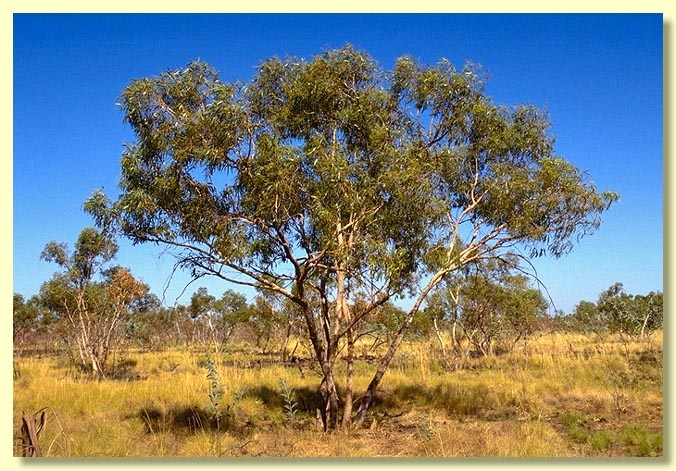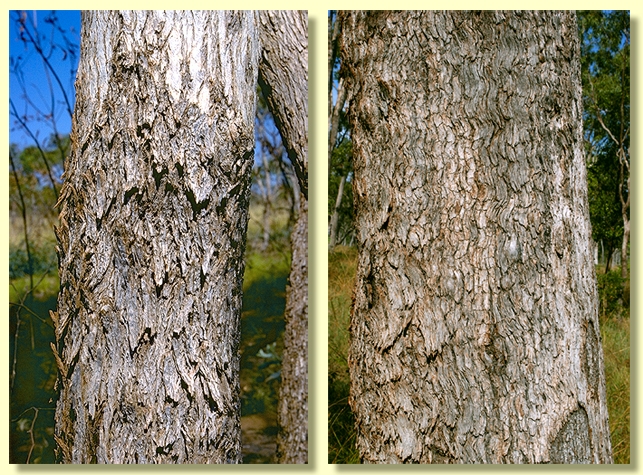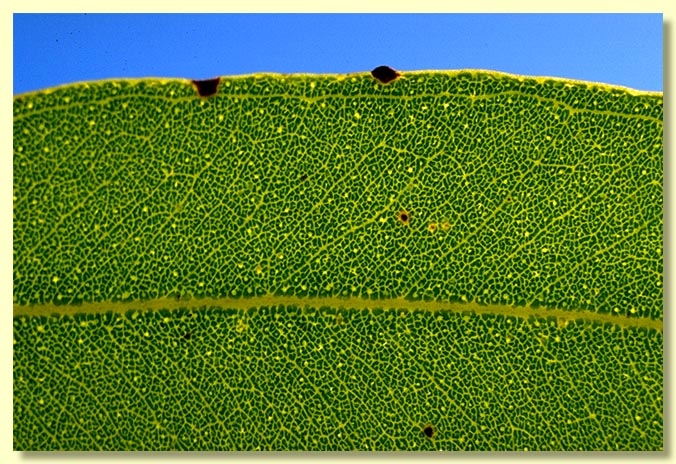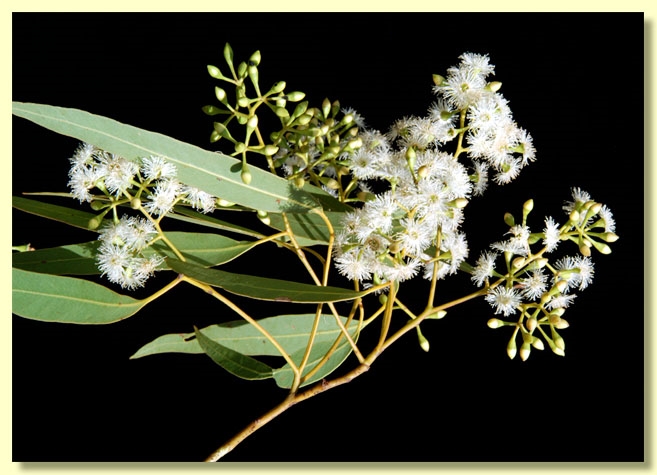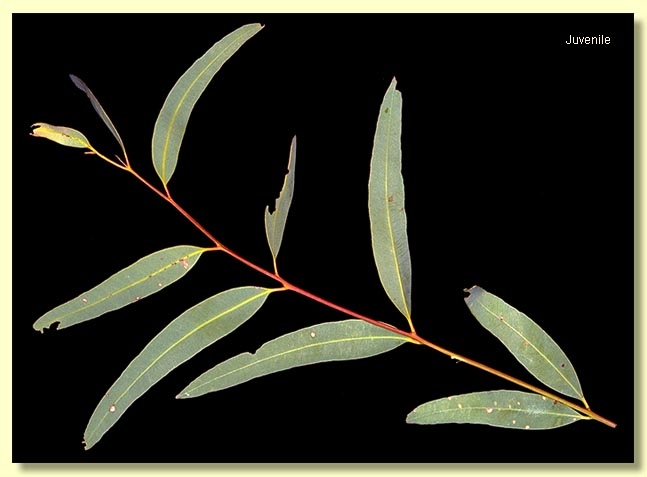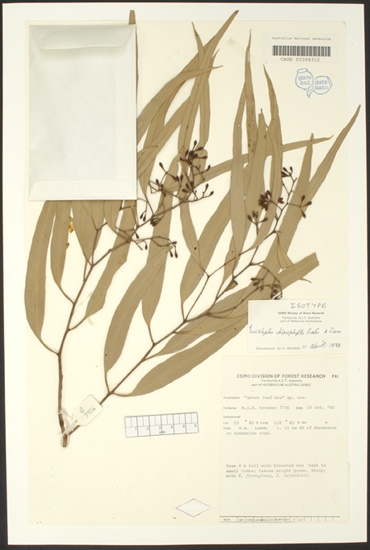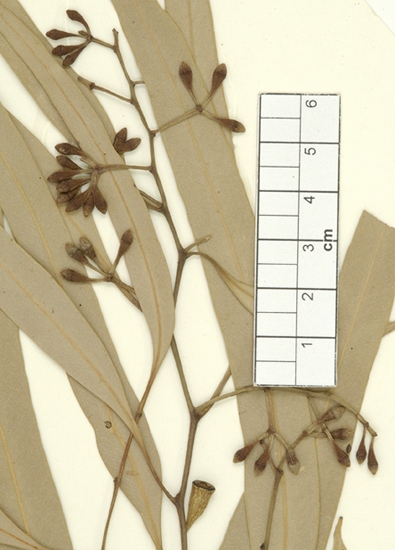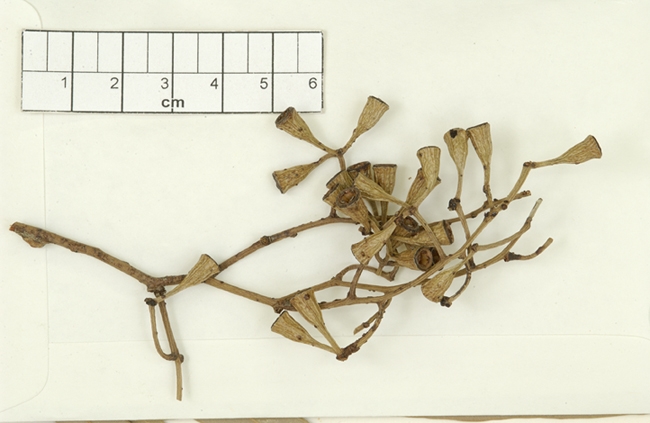Eucalyptus | Symphyomyrtus | Adnataria | Apicales | Aquilonares | Protrusae
Euclid - Online edition
Eucalyptus chlorophylla
Tree to ca 18 m or mallee to 6 m tall. Forming a lignotuber.
Bark rough to the small branches, hard, fissured, box-type or becoming tessellated or scaly, grey-brown to bleached grey.
Branchlets lack oil glands in the pith.
Juvenile growth (coppice or field seedlings to 50 cm): stems rounded in cross-section; juvenile leaves always petiolate, alternate, ovate to broadly lanceolate but lower leaves may be ± elliptical, 4–9 cm long, 1.4–3.2 cm wide, green to grey-green.
Adult leaves alternate, petioles 0.7–1.7 cm long; blade lanceolate or falcate, 7–16.5(21) cm long, (0.8)1–2.5 cm wide, base tapering to petiole, margin entire, apex pointed, concolorous, glossy, green, side-veins about 45° to midrib, reticulation very dense, intramarginal vein present but close to edge, oil glands scattered, intersectional.
Inflorescence terminal compound, peduncles slender, 0.2–1.4 cm long, buds 7 or sometimes irregular due to internode elongation within an umbel, pedicels 0.3–0.5 cm long. Mature buds ovoid sometimes slightly 4-angled basally (0.5–0.8 cm long, 0.3–0.4 cm wide), scar present (outer operculum shed early), operculum conical, stamens irregularly flexed, all fertile, anthers adnate, basifixed, cuboid to ± globoid, dehiscing by lateral slits, style long and straight, stigma blunt, locules 4, the placentae each with 4 vertical ovule rows. Flowers creamy white.
Fruit pedicellate (pedicels 0.1–0.8 cm long), usually obconical, less commonly cupular, 0.3–0.7 cm long, 0.3–0.6 cm wide, basally 4-angled or smooth, disc level or sometimes descending obliquely or even vertically, valves 4, held at rim level or exserted.
Seeds blackish brown, 1–2.5 mm long, flattened-ovoid and may be pointed at one end, dorsal surface shallowly reticulate to almost smooth, hilum ventral.
Cultivated seedlings (measured at ca node 10): cotyledons small, reniform; stems rounded or square in cross-section; leaves always petiolate (petioles 0.2–0.5 cm), opposite for 4 to 9 nodes then becoming alternate, linear to narrowly lanceolate, 3.2–13.3 cm long, 0.6–2 cm long, base tapering, dull, green to grey-green, concolorous.
Flowering has been recorded in November and December.
A small tree or mallee widespread across northern Australia east from near Fitzroy Crossing and Kununurra in the Kimberley region of Western Australia, through the Northern Territory at latitude from south of Mataranka to about Tennant Creek, extending east to the Gulf of Carpentaria hinterland, the Barkly Tableland and into Queensland around the gulf to southern and eastern Cape York Peninsula. Two early collections in remote parts of the Northern Territory, from Mount Doreen north of Yuendumu and Coniston Station on the Lander River suggest the species may extend further south. It prefers sandy to gravelly loams over laterite on plains. Eucalyptus chlorophylla is distinguished by its rough bark, crown of glossy green leaves and, usually, obconical fruit 0.3–0.6 cm wide with exserted valves.
Within its area of distribution there are a number of other box species that are likely to be confused with Eucalyptus chlorophylla. In the west of its range, where E. chlorophylla tends to be more of mallee habit rather than a tree, it is unlikely to be confused with many other species. E. tectifica, E. xerothermica, E. distans, E. microtheca and E. patellaris are all fully rough-barked boxes common to this area but all tend to be trees not mallees. E. tectifica, E. xerothermica, E. distans and E. microtheca are easily distinguished by having dull adult leaves. E. xerothermica differs further by having slightly wider fruit 0.6–0.9 cm wide. E. patellaris can sometimes have glossy green leaves. It differs by having much larger fruit to 1.2 cm wide. In Queensland, where E. chlorophylla tends to be commonly a tree rather than mallee, it could be confused with E. brownii, E. leptophleba, E. persistens and E. leucophylla. Of these only E. brownii has glossy green adult leaves. E. chlorophylla differs by having buds with an acute operculum (round in E. brownii) and larger fruit (0.3–0.6 cm wide in E. chlorophylla and 0.2–0.3 cm wide for E. brownii).
In the classification of Brooker (2000) Eucalyptus chlorophylla belongs in Eucalyptus subgenus Symphyomyrtus section Adnataria (the boxes) because the buds have two opercula, ovules are in four rows, seeds are flattened-ovoid, cotyledons are reniform, and anthers are rigid on the staminal filaments. Within section Adnataria, E. chlorophylla is part of a subgroup of box species with mostly tropical distribution, series Aquilonares subseries Protrusae, having inflorescences terminal on the branchlets, adult leaves very densely reticulate and fruit that are small, ± fragile and have exserted valves.
Eucalyptus chlorophylla: Greek chloro-, green and phyllon, leaf.

